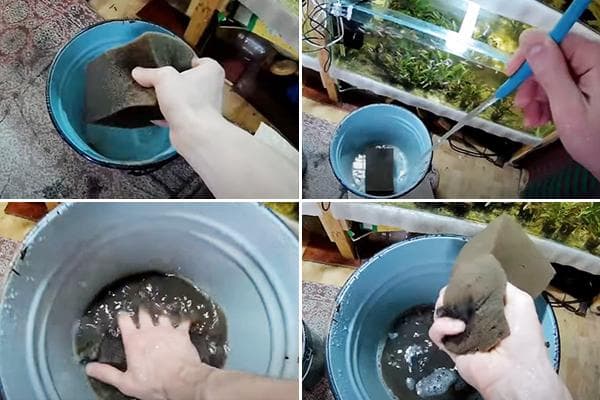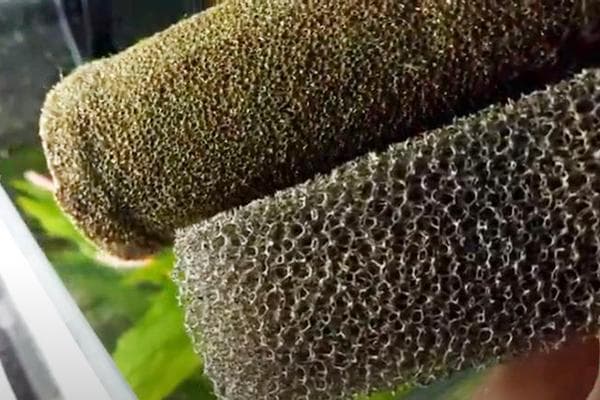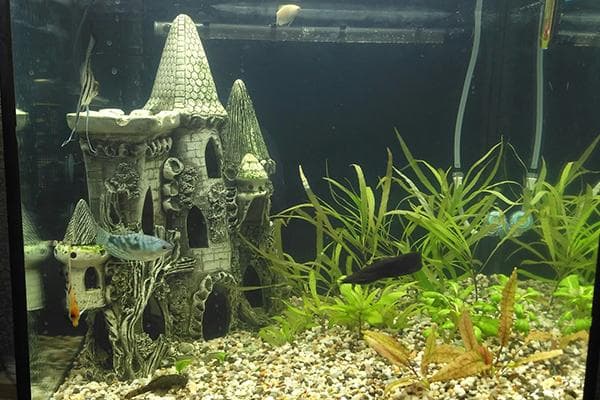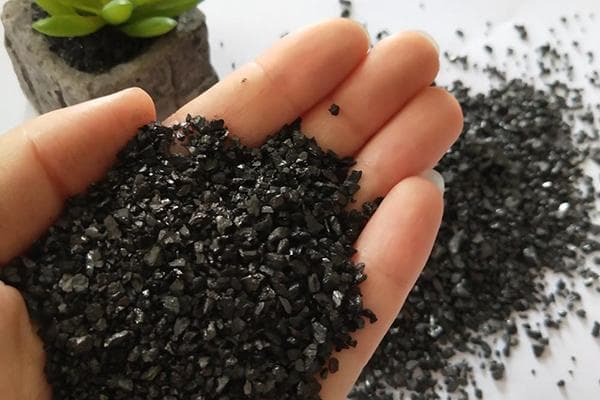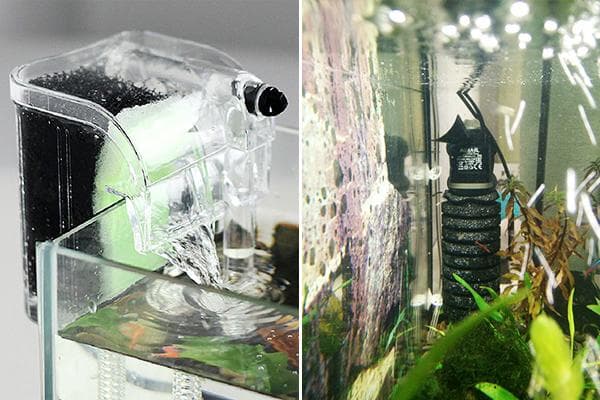How often does an aquarium filter need to be replaced and cleaned?
In any aquarium it is necessary to maintain the balance of the ecosystem. The owner’s task is to regularly clean the tank, change the filter in the aquarium, and add settled water. Waste products, food not eaten by fish, and the remains of dead plants accumulate in the tank, polluting the water, releasing dangerous ammonia, which can turn into nitrates and nitrites.
Each fish in an artificial habitat has less free space than in a natural reservoir. Lack of filtration and irregular water changes lead to deterioration of the conditions for keeping fish and their possible death.
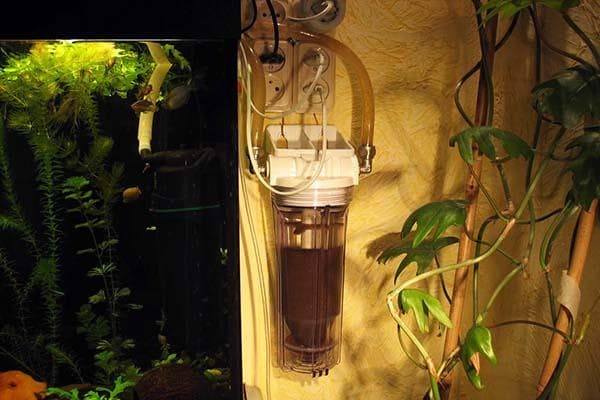
Filtering methods
In order for the filter to cope with its tasks, you need to understand what type your aquarium needs. When choosing, take into account the volume of the tank, the number and breeds of fish, other inhabitants, and plant species.
The filtration system should circulate water at least three times within an hour. If you are not sure of your calculations, get a more powerful device, this will allow you to avoid water contamination.
Water filtration occurs in one of the following ways:
- Mechanical. These are the simplest and at the same time effective filters for an aquarium. During the cleaning process, small debris and suspended matter are filtered out of the liquid. The pump pumps aquarium water through the sponge, sending purified water back into the tank.This is the best option for a small aquarium containing a small number of small fish.
- Chemical. In this design, the contaminated liquid is passed through sorbents, such as activated carbon, and ion exchange resins. Sorbents absorb not only mechanical, but also chemical harmful impurities that have entered the water (chlorine, heavy metal ions), ion exchange resins destroy toxins - ammonia, nitrates and nitrites, which are constantly formed and accumulated in any aquarium.
- Biological. These devices use the beneficial qualities of bacteria that ensure the conversion of ammonia into safe compounds. These beneficial bacteria live in the aquarium, and its owner needs to create conditions for their reproduction and vital activity. For this purpose, biological filters are filled with materials intended for the comfortable growth of bacteria - foam rubber, synthetic padding polyester, zeolite, expanded clay and others. The larger the surface area of the filler, the better it copes with its responsibilities. Fillers trap small debris, and bacteria living in the pores break down ammonia.
- Combined method, combining different cleaning options.
The filter can be located outside the aquarium, inside on the wall of the tank or at the bottom, under the soil, which in this case acts as a filter substance.
Filter selection
The well-being of all inhabitants of the aquarium depends on the efficiency of the device. To ensure their healthy functioning, it is necessary to choose the right filter and regularly care for it.
When purchasing, you need to consider a number of factors:
- the power of the device (the instructions indicate the volume of water passed through it for an hour);
- filter type;
- aquarium volume;
- number of fish and greens.
Some manufacturers indicate on the packaging the volume of the aquarium for which this device is designed. Experts recommend purchasing a filter “with a reserve” - designed for using a larger tank.
When choosing, pay attention to the noise created during its operation. This device operates constantly, so it is important that the sounds it makes do not interfere with your rest. Serious manufacturers are trying to produce high-quality silent products, but such filters are more expensive.
Also consider the possibility of quick and convenient assembly and disassembly, because you will have to regularly clean the insides of the device from dirt.
How to change and clean the filter correctly
Regardless of the filtration method and type of device, the aquarium filter requires regular maintenance - cleaning and replacing the filler. The water passing through the filler is purified, contaminating the filter with residues of organic compounds, waste of fish and other inhabitants of the aquarium, food, and greens. The cleaning efficiency decreases, and decaying organic matter begins to release dangerous toxins into the aquarium. This leads to a disruption of the ecological balance in the reservoir, deterioration of the conditions for keeping fish, and possible death of the inhabitants.
Mechanical cleaning
The most common filler for aquarium filters is a sponge. It provides mechanical cleaning, trapping dirt particles. Colonies of bacteria settle on it, providing biological filtration.
The smaller the pores of the sponge, the faster it becomes dirty and the more often it needs to be washed or replaced with new filler.
- Large-pored sponges last longer, but they allow suspended matter and fine dirt to pass through without providing adequate water clarity.
- Experienced aquarists recommend using a fine-pored sponge, changing and washing it more often.
The signal to replace the sponge is its destruction, spreading into separate parts. This usually happens no earlier than a year or two after the start of use. The sponges are replaced one at a time with an interval of 2 weeks.
The sponge must be washed in water without using cleaning agents, which will destroy the colony of nitrifying bacteria. For the same reason, you should not use hot water, especially boiling water. Experts recommend rinsing the sponge with water at room temperature, drained from the aquarium. It is important to do this “without fanaticism” - to remove only mucus and dirt.
If the sponge has collapsed and there is nothing to replace it with, select a material with a similar structure that does not rot in a humid environment and does not contain toxic substances. Can be used:
- household sponges,
- padding polyester,
- foam rubber,
- a lump of thin nylon fishing line.
This is a temporary measure. Sponges that are specially designed for this purpose cope best with filtration - they are made of special foam rubber.
If you use special cotton wool as a filler, there is no point in rinsing it; it’s easier to replace it with a new one.
Biological filtration
When using the biological principle of filtration, the filler is porous ceramics, sintered glass figures with small pores, and volcanic materials. Their surface is ideal for beneficial bacteria to live in, so the filler should be washed if absolutely necessary, being careful. For cleaning, use aquarium water at room temperature.Elements made of porous material must be replaced once every 3–6 months.
Sorbents
This type of filtration is usually used in unusual situations - for example, after treating fish.
Activated carbon and zeolite are widely used for filtration. They bind chlorine, air microbubbles, remove surfactants, phenols, pesticides, herbicides. Partially binds salts of heavy metals. Over time, the cleaning efficiency decreases, since the pores of the sorbent become clogged, the filler does not cope with its functions and simply takes up space in the tank.
It is impossible to restore activated carbon at home; it must be immediately replaced with fresh one. The service life of zeolite is 3 months.
How often should the filter be cleaned and replaced?
Each aquarium has its own unique ecological system with unique properties, depending on the following parameters:
- chemical composition of water;
- soil;
- number of inhabitants;
- species of fish, snails, shrimp;
- type and quantity of feed;
- plants;
- using chemicals to clean the filter and tank walls.
It is not easy to give general recommendations on the frequency of filter cleaning and replacement, since the load on the device and the rate at which it becomes dirty can vary significantly.
The regularity of cleaning and replacing the filter is affected by the design and quality of the device itself. Modern devices do not require frequent cleaning.
It should be taken into account that external filters do not occupy the free space of the tank and can be larger in size, therefore, a larger amount of filter material. They do not require maintenance, cleaning or replacement for a long time.
“Standard” recommendations: the internal filter needs to be cleaned weekly, and the external filter needs to be cleaned monthly. These are approximate dates; you need to focus on the condition of the water in the aquarium. An important indicator is the pressure of the water stream coming from the filter. If it has decreased, then it’s time to rinse the filler.
A serious reason to wash or replace the filter is fish disease. After treatment and recovery of the aquarium inhabitants, unscheduled cleaning of the aquarium walls and the entire filter system is necessary. It is necessary to rinse the filter media to remove harmful microorganisms and drug residues to avoid re-infection. Many medications negatively affect beneficial bacteria that provide biofiltration.
It is also necessary to wash the filter if it has been turned off for more than 2 hours. A break in work will lead to the death of beneficial bacteria, turning them into a toxic mass. If you turn on the filter without pre-treatment, toxic substances will enter the water.
A filter for water purification is one of the necessary components of an aquarium. It not only purifies water, but also enriches it with oxygen. Please note that the filter in the aquarium must work continuously, without stopping. If for some reason it has been idle for several hours, unscheduled cleaning is necessary. Observe the aquarium - over time, you will be able to independently determine the frequency of caring for the aquarium and replacing the filler in the filter.
